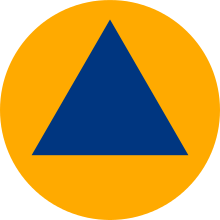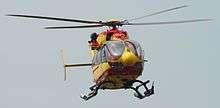Sécurité Civile

Operating for the French Ministry of the Interior, the Direction de la Défense de la Sécurité Civile (Department of Civil Defence and Emergency Preparedness) is a civil defence agency of the French Government and employs some 2,500 civilian and military personnel over 60 sites.[1] Known as the Protection Civile until 1976,[2] the Sécurité Civile is split into several branches.
The Sous-Direction des Sapeur-pompiers are the French firefighters.
The Sous-Direction des opérations de Secours et de la coopération civilo-militaire [3](Rescue operation and civil-military cooperation branch) is involved in bomb disposal, coast guard, mountain rescue, air ambulance (MEDIVAC and aerial firefighting duties.
Aircraft

Sécurité Civile aircraft operate for the Rescue operation and civil-military cooperation branch under the Groupement des Moyens Aériens Sécurité Civile (Aerial Group).[3] Aircraft carry the title SECURITE CIVILE on the fuselage sides, together with the international civil defence symbol. The aircraft are divided into the Groupement des Helicopteres de la Securite Civile (Helicopter Group) and the Groupement des Avions Bombardiers d'Eau (Water Bomber Group).[4]
Helicopter group


The Sécurité Civile helicopter group has 22 helicopter bases in mainland France and its overseas territories. It has a fleet of 40 helicopters and employs 230 pilots and flight engineers and 50 ground engineers. Over its 50 years of activity, the helicopter group has an impressive track record, with 480,000 flight hours, 250,000 rescue missions and 225,000 people rescued.[5] Helicopter group aircraft use the callsign "DRAGON", followed by the number of the département in which their base is located.[2]
Six Aerospatiale Alouette III SA316B are still in operation, based at Alpe d'Huez, Chamonix, Nîmes and Paris.[6]
Four Eurocopter Écureuil AS-350 are operated out of Cannes, Nîmes and Marseille.[6]
- Eurocopter EC145 (35)
Sécurité Civile currently operates 35 EC-145 helicopters that were delivered between 2002 and 2005. The fleet has accumulated over 100,000 flight hours.[5] The EC-145 fleet is used for search and rescue, fire fighting, emergency medical services (EMS), surveillance and law enforcement. EC-145s are deployed on 22 Sécurité Civile bases in France and the French Overseas Territories. An order has been placed for a further five helicopters, to be delivered from January 2009. This will enable the phasing out of the six remaining Alouette III helicopters.[7] The EC 145 carries out an average 10,000 rescue missions each year, representing over 13,300 flight hours.[5]
Bases
Helicopter group bases of operation are located at:.[8]
- Ajaccio (Corsica)
- Annecy
- Bastia (Corsica)
- Besançon
- Bordeaux
- Cannes
- Clermont-Ferrand
- Granville
- Grenoble
- Le Havre
- Lille
- Lorient
- Lyon
- Marseille
- Montpellier
- Paris - Issy-les-Moulineaux
- Pau
- Perpignan
- Pointe-à-Pitre (Guadeloupe)
- Quimper
- La Rochelle
- Strasbourg
The Echelon Central (command centre), and helicopter maintenance base is located in Nîmes.
Helicopters are detached to several other bases seasonally. In summer, aircraft are detached to Courchevel, Alpes d'Huez, Gavarnie, Lacanau, and Chamonix. In winter, aircraft are detached to Chamonix and Alpes d'Huez.[8]
Water bomber group


%2C_France_-_Securite_Civile_AN0205116.jpg)
- Bombardier 415 (12)
12 Bombardier 415s are currently operated by the Sécurité Civile, each able to drop 5,800 l (1,300 imp gal; 1,500 US gal).[9] France was the first nation to commit to the CL-415 "Superscoop" in 1992, so that it could phase out its Canadair CL-215s.[10]
Two pre-owned Bombardier Dash 8 Q400s, acquired from Scandinavian Airlines System, were modified by Cascade Aerospace of Abbotsford, British Columbia, for the Sécurité Civile to act as fire-fighting water bombers in fire season and as transport aircraft off season. This aircraft is designated the Q400-MR (Multi Role). The aircraft can be reconfigured into the passenger, cargo or aerial fire control role in under three hours[11] and can drop 10,000 L (2,200 imp gal; 2,600 US gal) in the tanker role.[12]
Nine Conair Turbo Firecats are in operation.[10] The Turbo Firecat is a turboprop conversion of the Grumman S-2 Tracker, carried out by Conair (now Cascade Aerospace), Canada. The first delivery to the Sécurité Civile was in August 1988.[13]
Bases
All fixed-wing aircraft are based at Marseille Provence Airport.
Bomb disposal
307 Sécurité Civile bomb disposal experts are based at 20 bomb disposal units, including 2 overseas units (Guadeloupe and French Guiana). They are responsible for the detection, removal, disposal or destruction of suspicious objects. They also provide assistance during official travel or large demonstrations and de-arm and destroy unexploded ammunition still present from the two world wars.[14]
In 2004, 440 tonnes (430 long tons; 490 short tons) of munitions was disposed of, whilst 43 bomb disposal experts were deployed on the 60th anniversary of the Normandy landings, 17 on the 60th anniversary of the landing in Provence and 16 during the visit of Pope John Paul II to Lourdes.[14]
References
- ↑ French Interior Ministry - Sécurité civile (in French)
- 1 2 Helicopter group history (in French)
- 1 2 Sécurité Civile Organisational Chart (in French)
- ↑ Aeroflight - World Airforces: France
- 1 2 3 Turbomeca and Securite Civile celebrate 100,000 flight hours of the Arriel 1E2
- 1 2 Securite Civile Helicopters (in French)
- ↑ DGA orders 5 Eurocopter EC145 helicopters for Sécurité Civile
- 1 2 Helicopter group organisation (in French)
- ↑ Envoi de deux Canadair sur l'île de Rhodes (French)
- 1 2 Keijsper, Gerard (July 2008). Airforces Monthly: 'Water-Bombers Required!'. London: Key Publishing. pp. 38–44.
- ↑ Cascade Aerospace - Q400 Airtanker Conversion
- ↑ De Havilland Canada Dash 8
- ↑ Janes - Cascade Aerospace (Conair) Turbo Firecat Conversion
- 1 2 "Le service du déminage de la sécurité civile" (in French). Ministre de l’Intérieur. 2010-05-17. Archived from the original on 2012-05-23.
External links
| Wikimedia Commons has media related to Sécurité Civile. |
- French Interior Ministry - Sécurité Civile (in French)
- Sécurité Civile Helicopters (in French)
- Sécurité Civile Helicopters fleet